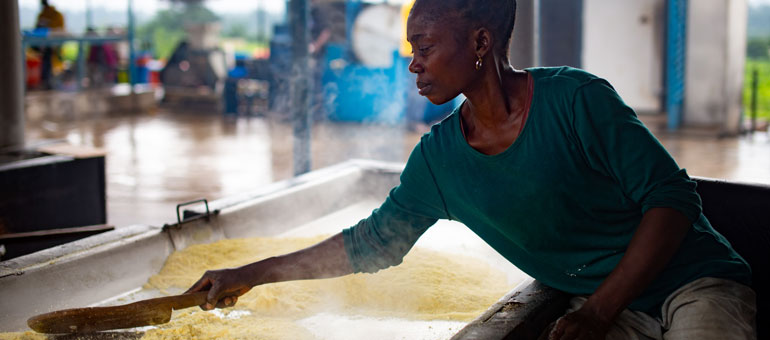Last year on this blog, I announced the GAIN Business Model Research (BMR) Project: funded by the Netherlands Ministry of Foreign Affairs, this project aims to identify promising business models to reach consumers on lower incomes with nutritious foods. Such approaches could help to improve the quality of diets—which currently are often lacking in food diversity and quality—if they can provide food that meets customers’ needs at an affordable price. But they must do so in ways that are profitable and sustainable for the company. How can they do this?
To find out, the BMR project undertook a systematic review of existing research and evidence. We screened about 8,000 documents before selecting 74 documents, and 99 case-study companies, that were eligible for inclusion. We included companies producing highly nutritious foods as well as those producing less nutritious alternatives—with the understanding that they might offer insights that could be applied to nutritious foods. We then analysed these documents to extract and synthesise 13 specific approaches used by firms to reach lower-income consumers with food and beverage products. Here, we discuss one of these approaches.
From the consumer perspective, product costs can include not only monetary costs but also time and effort costs of acquiring, preparing, and consuming foods: for the consumer, these jointly shape the product's effective affordability. The cost of time and fuel to prepare food is not insignificant in many low- and middle-income countries. For example, an analysis of the cost of cooking beans in six African countries found that the cost of the fuel needed to cook beans was often over 50% of the cost of the dried beans themselves, depending on the fuel used. In addition, as many low-income people are time-poor (e.g., needing to work multiple jobs as well as provide care at home), they often place a premium on convenience and saving time.

Several companies sell pre-cooked porridges (often fortified and directed at young children), which are either ready-to-eat/drink or require only a few minutes of preparation. © GAIN
As such, firms that can find innovative ways to make a product more convenient and faster to prepare can enhance the perceived value of the product — increasing its effective affordability for the consumer. As firms working at scale and with industrial-scale equipment and trained employees can often process food more efficiently than home cooks, this can create a surplus whereby the effective cost to the consumer (product cost, minus fuel costs and value of cooking time) can be kept low enough to be affordable while still ensuring a profit for the firm. Convenience can also work to attract customers to nutritious or new products that they previously considered too difficult or time-consuming to prepare (e.g., legumes).
The BMR review found that this strategy was primarily used for legume-based products and porridge flours. For example, Smart Logistics Solutions in Kenya produces multiple bean-based convenience foods: pre-cooked dehydrated beans, bean flours, and bean-enhanced instant noodles. These can all be cooked in just a few minutes, with minimal fuel and water, creating a 'modern and easy' product from one traditionally seen as laborious and time-consuming. Indeed, Maggi instant noodles were found to quickly penetrate the market in Papua New Guinea, even among low-income households, due to the ease of consumption compared to traditional staples (which cost less). Another Kenyan firm, Kwanza Tukule, pre-cooks beans and delivers them directly to street vendors — mostly women, who sell mostly to low-income laborers — using a mobile app. This provides considerable convenience for vendors by cutting costs for both procurement and preparation; 63% of the firm’s client vendors report purchasing due to this time saving. Using a more traditional approach, Banda Borae Cooperative in Ghana transforms soybeans into ready-to-eat street food: grilled tofu kebabs.
Several companies sell pre-cooked porridges (often fortified and directed at young children), which are either ready-to-eat/drink or require only a few minutes of preparation. For example, Nutri’Zaza (a Malagasy initiative initially started by the French NGO GRET and now an independent social enterprise), produces a fortified grain-and-legume infant flour, which is sold ready-to-eat in poor urban neighbourhoods, either at 'baby restaurants' or by door-to-door sales persons, as well as in a dried form at stores. A serving costs less than 10 US cents (or 4-8% of the budget of a minimum-wage family), and 12.9 million meals were distributed in 2020. The convenience of not needing to shop, cook, or fetch fuel and/or water was appreciated by mothers and resulted in high levels of reach; 40% of caregivers reported time-saving to be the main advantage of the product.
At the same time, it is by no means a given that a more convenient product will be affordable: the same analysis cited above found that purchasing canned beans in the six studied countries would cost roughly 3-4 times the cost of dry beans plus cooking fuel, and that choosing pre-cooked foods in general would roughly double the costs of a basic meal. To achieve affordability, the product must be reasonably cheap to prepare and package in a convenient form, and that savings must be passed on to the consumer.
Product designers who recognise the value that lower-income people place on their limited time can create added value for their customers, making a product effectively more affordable to them – and in the process encouraging consumption of nutritious foods.